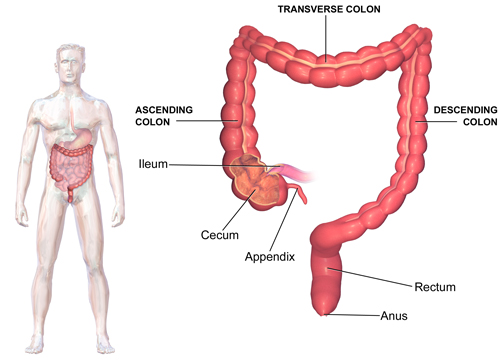 The small intestine absorbs nutrients and the large intestine eliminates waste. |
After the bolus is swallowed, it enters the stomach through the esophagus. Then mechanical and chemical digestion in the stomach break it down further to produce chyme. The chyme leaves the stomach to enter the last section of the digestive tract, the small and large intestines. Although these two structures are both called intestine, their functions are different from one another. Click each tab to learn their functions.
Small Intestine
Large Intestine

The small intestine is really not very small. In an average adult, it is about 6 meters (20 feet) long, and about 2.5 centimeters (1 inch) in diameter. It has three parts. The duodenum comes first and connects to the stomach, the jejunum makes up the middle section, and the ileum is last and leads to the large intestine. The inside of the small intestine is lined with many tiny fingerlike projections called villi (one single structure is called a villus). As chyme moves through the small intestine, more enzymes break down nutrients into smaller parts. The small intestine is also where absorption takes place. During absorption, materials like water, sugar, and protein parts enter the bloodstream through small blood vessels and are carried throughout the body.

The large intestine, sometimes called the colon, is only about 1.5 meters (5 feet) long, but it is about 7.5 centimeters (3 inches) in diameter. It also has three parts: the ascending, transverse, and descending colons. In addition, it has one "blind" end, called the cecum, which doesn't lead anywhere. On the end of the cecum is the appendix. The appendix does not function in humans. The main job of the large intestine is to compact any waste that can't be used by the body, and store it in the rectum until it is expelled through the anus. The large intestine also makes vitamin K, which is essential for helping blood to clot (to form scabs) after an injury like a cut.
The small and large intestines together make up the end of the digestive tract. Although they are both intestine, they have very specific functions. In the activity below, test your knowledge of the structure and functions of the intestines by matching the description or function on the left with the related organ on the right. Keep in mind that the large intestine is sometimes called the colon.
|
absorption of nutrients
|
small intestine
large intestine
appendix
|
|
elimination of wastes
|
small intestine
anus
villi
|
|
contains villi
|
small intestine
appendix
rectum
|
|
absorbs some water and makes vitamin K
|
villi
anus
colon
|
Complete